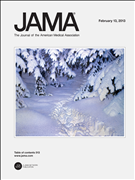JAMA:治疗网球肘不宜注射皮质醇
2013-02-17 JAMA 医学论坛网 小康
澳大利亚昆士兰大学的Coombes等2月6日在《美国医学会杂志》[JAMA 2013,309(5):461-9]上发表的一项随机对照临床试验表明,对于肱骨外上髁炎(网球肘)患者,注射皮质类固醇和物理治疗1年后的完全恢复和显著改善率低于安慰剂治疗,并且复发率升高。 Effect of corticosteroid injection, physiotherapy, or both o
澳大利亚昆士兰大学的Coombes等2月6日在《美国医学会杂志》[JAMA 2013,309(5):461-9]上发表的一项随机对照临床试验表明,对于肱骨外上髁炎(网球肘)患者,注射皮质类固醇和物理治疗1年后的完全恢复和显著改善率低于安慰剂治疗,并且复发率升高。

Importance
Corticosteroid injection and physiotherapy, common treatments for lateral epicondylalgia, are frequently combined in clinical practice. However, evidence on their combined efficacy is lacking.
Objective
To investigate the effectiveness of corticosteroid injection, multimodal physiotherapy, or both in patients with unilateral lateral epicondylalgia.
Design, Setting, and Patients
A 2 × 2 factorial, randomized, injection-blinded, placebo-controlled trial was conducted at a single university research center and 16 primary care settings in Brisbane, Australia. A total of 165 patients aged 18 years or older with unilateral lateral epicondylalgia of longer than 6 weeks' duration were enrolled between July 2008 and May 2010; 1-year follow-up was completed in May 2011.
Interventions
Corticosteroid injection (n = 43), placebo injection (n = 41), corticosteroid injection plus physiotherapy (n = 40), or placebo injection plus physiotherapy (n = 41).
Main Outcome Measures
The 2 primary outcomes were 1-year global rating of change scores for complete recovery or much improvement and 1-year recurrence (defined as complete recovery or much improvement at 4 or 8 weeks, but not later) analyzed on an intention-to-treat basis (P < .01). Secondary outcomes included complete recovery or much improvement at 4 and 26 weeks.
Results
Corticosteroid injection resulted in lower complete recovery or much improvement at 1 year vs placebo injection (83% vs 96%, respectively; relative risk [RR], 0.86 [99% CI, 0.75-0.99]; P = .01) and greater 1-year recurrence (54% vs 12%; RR, 0.23 [99% CI, 0.10-0.51]; P < .001). The physiotherapy and no physiotherapy groups did not differ on 1-year ratings of complete recovery or much improvement (91% vs 88%, respectively; RR, 1.04 [99% CI, 0.90-1.19]; P = .56) or recurrence (29% vs 38%; RR, 1.31 [99% CI, 0.73-2.35]; P = .25). Similar patterns were found at 26 weeks, with lower complete recovery or much improvement after corticosteroid injection vs placebo injection (55% vs 85%, respectively; RR, 0.79 [99% CI, 0.62-0.99]; P < .001) and no difference between the physiotherapy and no physiotherapy groups (71% vs 69%, respectively; RR, 1.22 [99% CI, 0.97-1.53]; P = .84). At 4 weeks, there was a significant interaction between corticosteroid injection and physiotherapy (P = .01), whereby patients receiving the placebo injection plus physiotherapy had greater complete recovery or much improvement vs no physiotherapy (39% vs 10%, respectively; RR, 4.00 [99% CI, 1.07-15.00]; P = .004). However, there was no difference between patients receiving the corticosteroid injection plus physiotherapy vs corticosteroid alone (68% vs 71%, respectively; RR, 0.95 [99% CI, 0.65-1.38]; P = .57).
Conclusion and Relevance
Among patients with chronic unilateral lateral epicondylalgia, the use of corticosteroid injection vs placebo injection resulted in worse clinical outcomes after 1 year, and physiotherapy did not result in any significant differences.
本网站所有内容来源注明为“梅斯医学”或“MedSci原创”的文字、图片和音视频资料,版权均属于梅斯医学所有。非经授权,任何媒体、网站或个人不得转载,授权转载时须注明来源为“梅斯医学”。其它来源的文章系转载文章,或“梅斯号”自媒体发布的文章,仅系出于传递更多信息之目的,本站仅负责审核内容合规,其内容不代表本站立场,本站不负责内容的准确性和版权。如果存在侵权、或不希望被转载的媒体或个人可与我们联系,我们将立即进行删除处理。
在此留言








#皮质醇#
128